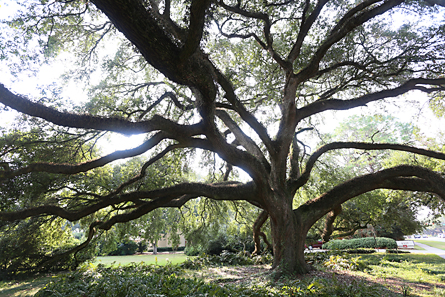Students at the University of Ẵ»῭ÇÖ±²¥ at Lafayette are creating an inventory of trees on campus. The information they've collected helped the University earn its fifth consecutive designation as a Tree Campus USA by the Arbor Day Foundation.
"This designation reflects our commitment to planting and maintaining trees," said Mike Hess, UL Lafayette's grounds manager.
To become a Tree Campus USA, a university must establish a campus tree advisory committee, create a campus tree-care plan, verify dedicated annual expenditures on the campus tree plan, hold an Arbor Day observance, and develop a service-learning project involving students. Universities must re-apply each year to receive the designation.
Students in UL Lafayette's Community Design Workshop surveyed the campus to create a database and digital map of more than 1,000 plants. The inventory includes trees and large shrubs, such as crape myrtles and camellias. Students photographed each plant, noted its common and Latin name, the dimension of the trunk and canopy and its location on campus. Each specimen is identified with a unique number.
The inventory of the main campus began in 2011 and is almost complete.
Tom Sammons, director of the School of Architecture and Design, also leads the CDW. "We have about a dozen trees left to measure. They're in Cypress Lake and we just haven't been able to access that area because of construction."
Cypress Lake, UL Lafayette's managed wetland, is adjacent to the Student Union, which is being expanded and renovated. Work is expected to be complete by the end of the year.
The ongoing inventory will eventually include University Common, said Sammons. About 40 students, including undergraduate and graduate students, have participated in the effort.
The CDW provides expertise in urban planning and landscape design, as well as architecture, housing and preservation. Faculty members provide expert consultation and planning services, while fifth-year architecture students earn course credit and gain practical experience by transforming planning concepts into digital drawings and models.
The CDW has worked with communities and neighborhoods to complete more than 90 development plans. It has also helped create the University's Master Plan, which includes urban landscaping.
Hess said his office has an inventory from the 1980s "But of course, it's all on paper and very much out-of-date. Having a current inventory will help us better manage our trees on campus," he said.
